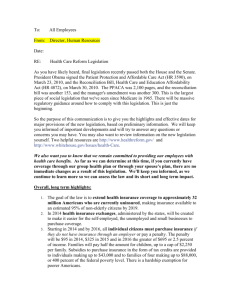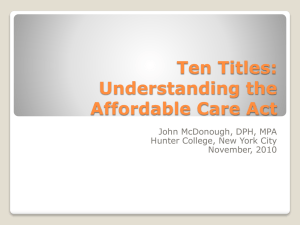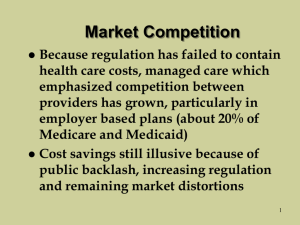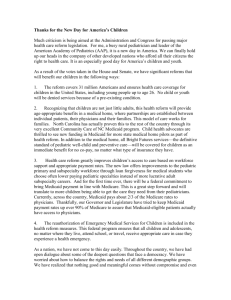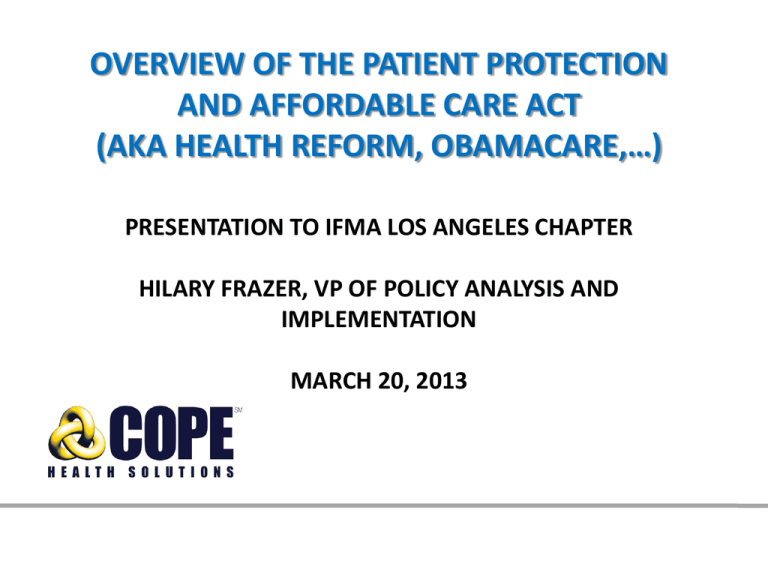
OVERVIEW OF THE PATIENT PROTECTION
AND AFFORDABLE CARE ACT
(AKA HEALTH REFORM, OBAMACARE,…)
PRESENTATION TO IFMA LOS ANGELES CHAPTER
HILARY FRAZER, VP OF POLICY ANALYSIS AND
IMPLEMENTATION
MARCH 20, 2013
General Disclaimer
• The ACA is an incredibly complex piece of legislation and many of its
provisions have been (and are still being) modified. It is designed to affect
every aspect of health care delivery and financing in the US.
• Like all legislation, effectiveness can only be measured after
implementation occurs
• The state-federal dynamic is (as always) a game changer…
• Differences in underlying market conditions, state fiscal health, provider
supply and attitudes, adequacy of the safety net, and a host of other
variables, including state median income level, competency of state
bureaucrats, power of special interests and the broker community, preexisting rates of uninsurance, managed care penetration in public and
private insurance sectors, degree of erosion that occurs in the employersponsored insurance market after 2014, etc. -- all of these and many
other factors will also affect reform implementation in each state and
major insurance market
• At this time, nobody can say with absolute certainty in what ways the ACA
will meet its objectives and in what ways it will fail
2
“Improving the U.S. health care system
requires simultaneous pursuit of three aims:
improving the experience of care, improving
the health of populations, and reducing per
capita costs of health care.”
Donald Berwick
Copyright © 2013 COPE Health
Solutions. All rights reserved
3
Roadmap to this Presentation
1.
2.
3.
4.
-
5.
ACA Context, Vision, Approach, Goals
Policy Changes Since Enactment
ACA-Driven Insurance Reforms
- Individual
- Small Business
- Large Employer
Exchange Marketplace
- State variations
-Tax credits (subsidies)
- EHBs & QHPs & actuarial value
ACA in CA
- Individual
- Small group
- Large group
- Public programs (Medi-Cal, CHIP, Medicare)
4
Why is health reform needed?
1
Primary Goal of Health Care Reform:
Reduce the Number of US Uninsured
Total = 300.5 million
Uninsured
15%
About 45 Million
Uninsured
Medicaid/
Other Public
13%
EmployerSponsored
Insurance
52%
Medicare
14%
Private NonGroup
5%
NOTE: Includes those over age 65. Medicaid/Other Public includes Medicaid, SCHIP, other state programs, and military-related
coverage. Those enrolled in both Medicare and Medicaid (1.9% of total population) are shown as Medicare beneficiaries.
SOURCE: Kaiser Commission on Medicaid and the Uninsured/Urban Institute analysis of March 2009 CPS
Major Design Elements of Health Reform
•
•
•
•
•
•
•
•
•
•
•
•
•
•
Individual Mandate
Employer Requirements
Expansion of Public Programs
Premium and Cost-Sharing Subsidies to Individuals
Tax Changes
Health Insurance Exchanges
Benefit Design
Changes to Private Insurance
State Role
Cost Containment
Improving Quality/Health System Performance
Prevention/Wellness
Long Term Care
Other Investments in health care system and workforce training and
development
7
Health Reform Goals:
Slide from
August 7, 2009, 6:00 am
Lost in the Shuffle: The Overarching Goals of Health Reform
By UWE E. REINHARDT NYT 8/2009
8
ACA Coverage and Financing Estimates
(prior to Supreme Court Decision and Fiscal Cliff Negotiations)
• CBO estimated health reform would provide
coverage to an additional 32 million Americans
through combination of Exchanges and the
Medicaid expansion
• Estimated cost of coverage components of new
law to be $938 Billion over ten years
• Costs financed through savings from Medicare
and Medicaid and new taxes and fees, including
an excise tax on high-cost insurance
• CBO estimated health reform law would reduce
the deficit by $124 Billion over ten years
9
Who Benefits from the Affordable Care Act Coverage Expansions?
Percentage of the Nonelderly Population With Income Up to Four Times the Poverty level
Who Were Uninsured or Purchasing Individual Coverage, 2010
What’s Changed?
• Medicaid expansions are the platform upon which all other reforms
are premised BUT Supreme Court decision allows States to opt NOT
to expand their Medicaid programs
• Decision to expand Medicaid has become a state level political
litmus test for some conservative Republicans
• States that decide against expanding their Medicaid programs
(initially expansions are funded almost entirely with federal money)
could leave their low and moderate income residents uninsured
and with even fewer options than before reform
• Being uninsured after reform occurs will likely result in even greater
problems in access to appropriate and affordable care because so
much of reform approach is reallocation of dollars in US health care
system to ensure access to the newly insured
• Stay tuned: “Rebel” states and Feds are now looking for
compromise solutions….
11
Perspective is everything when you’re
talking about health reform….
ACA Reforms Three Insurance
Marketplaces
Individual Market (Individual Mandate)
– Guarantee issue/No medical underwriting
– Metal Plans (bronze, silver, platinum) and Essential Benefits
– Carriers with regulated rates
– Access via Exchanges and insurance brokers or carriers directly
Small Group Market (2-50 employees) (NO Mandate)
– Guarantee issue/No medical underwriting
– Metal Plans and Essential Benefits
– Carriers with regulated rates
– Access vie Exchanges and insurance brokers or carriers directly
Large Group Market (50+ employees) (Pay or Play Mandate)
– Guarantee Issue but groups are underwritten so rates can be high
– Minimum actuarial value (60%) for plans but freedom to vary from essential
benefits
– Carriers (15% expenses) plus self-funding options, rates not regulated
– Access via insurance brokers
13
Individual Mandate
Starting in 2014 there’s a penalty for not having health insurance
The penalty is non-deductible excise tax that is the HIGHER of…
2014
1% of income
or
$95/person
2015
2016
2% of income or $325/person
2.5% of income or $695/person
Flat $ penalties are capped at three persons per family (300% of above
figures)
Percentage caps at average cost of the Bronze Level benefit program
No penalty for not having insurance IF no access to affordable health
insurance through an employer AND cost of individually purchased
insurance exceeds more than a certain percentage of annual income
(percentage is based on annual income and tops out at 9.5%)
14
2013 Annual Income/Federal Poverty
Levels
15
Federal Tax Credits/Subsidies
• Health Insurance Premium subsidies for individuals with annual incomes
between 133% up to 400% of the federal poverty level (FPL)
• On paper estimates indicate tax credits could help up to 25 million lowincome Americans
• No tax credit for those who end up earning more than 400% FPL ($92,200)
for a family of 4 (and tax credits claimed for the year will need to be
repaid)
• No tax credit for married couples who don’t file jointly
• Much of the final regulation around the subsidies is still being completed
by Treasury
16
What are Essential Benefits?
Applies to Small Group and Individual Markets
–
–
–
–
–
–
–
–
–
–
Ambulatory patient services
Emergency services
Hospitalization
Maternity and newborn care
Mental health and substance abuse
Prescription drugs
Rehabilitative care and Habilitative care (such as learning disabilities)
Laboratory services
Preventive and wellness services
Pediatric services, including oral and vision care
• California Benchmark Plan (for tax credits) is Kaiser’s Small Group $30
Copay HMO Plan
17
How Will Insurers Set Rates?
Copyright © 2013 COPE Health
Solutions. All rights reserved
18
19
Exchanges
Exchanges are government run internet-based health
insurance “shopping malls” meant to assist individuals and
small businesses in finding the best possible coverage
Open for business by October 2013 (for coverage starting on January 1, 2014
Only Citizens and Legal Immigrants
can access the Exchanges and therefore
qualify for Federal Subsidies
20
Benefit Levels
In the Individual and Small Group Markets: Bronze, Silver, Gold & Platinum
Benefit Qualified Health Plans (QHPs) will be offered
Each level will be ACTUARIALLY VALUED to cover 60% / 70% / 80% / 90%
of costs
CMS has released the Actuarial Value Calculator (Ind. + Small Group)
CMS has released the Minimum Value Calculator (Large Group)
Expectation is that annual out-of-pocket costs (including deductibles and
co-pays) cannot exceed:
$6,500 for single coverage
$13,000 for family coverage
NO Annual Benefit Caps
Actuarially equivalent plans don’t have to be equal in terms of benefits etc. so it
will be very important to confirm that a plan truly meets an individual’s/family’s
needs
23
National Map of Exchanges
StateState
Run Run StateState
+ Fed+ Run
Fed RunFed Fed
State Run
State + Fed Run
Fed
24
Small Group Employers
(2-50 FTE workers)
Beginning in 2014, Exchanges will also operate a Small Business Health
Options Program – or SHOP – that offers small businesses and their
employees Qualified Health Plans (QHPs).
SHOPs are meant to:
• Simplify Choices. Provide side-by-side comparisons of Qualified Health
Plans, their benefits, premiums, and quality.
• Expand Employee Options. Offer employees a choice of Qualified Health
Plans from several insurers, much as large employers can.
• Preserve Employer Control. Employers can decide whether and when to
participate in SHOP. You will be able to choose your own level of
contribution toward your employees’ coverage, and make a single monthly
payment via SHOP rather than to multiple plans.
• Lower costs. SHOPs spread insurers’ administrative costs across more
employers. In addition, very small businesses may be eligible for small
business tax credits when employee coverage is purchased through a
SHOP.
For information on Covered CA’s SHOP go to www.hbex.ca.gov
25
What about Large Group Market?
(Employers with 50+ FTE employees)
Starting 1/1/2014, the ACA requires large employers (defined as having
50+ full-time equivalent workers in 2013) to either Play (offer affordable
health coverage to their workforce) or Pay a penalty to the federal gov’t
§ 4980H(a) If NO COVERAGE is offered (to 5% or more of your full time
workers) – the penalty is $166.67 per mo. ($2,000/year) for ALL full-time
workers (the employer is not charged a penalty for the first 30 workers)
§ 4980H(b) If coverage IS offered but is deemed unaffordable or falls
short of minimum essential benefits, then certain low income employees
can potentially expose the employer to penalties of up to $250 per
employee per mo. ($3,000 per year)
Groups of employers are treated as one employer
if applicable under IRC § 414 (b) (c) (m) or (o)
26
How much is the penalty for nonoffering large CA employers?
It’s a NON-Deductible Business Expense
Federal Corporate Tax Rate is 35%
California Corporate Tax Rate is 8.84%
Combined Tax Rate is 43.84%
For every $1.00 of non-deductible expenses a business
has, it must make $1.78 (and the $.78 goes in corporate
taxes and then the $1.00 can be paid to the IRS as the
penalty)
Therefore the REAL penalty for not providing coverage is:
$296.77 per employee per month,
$3,561.25 per employee per year
27
Full-time employees are those working 30 or
more hours per week
Part Time employees (i.e., those working less
than 30 hours per week) are counted as fractions of
a full-time employee, on a monthly basis, by taking
their total number of monthly hours worked divided
by 120 hrs. (some sources say 130 hrs.)
EXCLUDE S seasonal employees (if they work for
less than 120 days during the year and excluding
them leaves fewer than 50 remaining FTE workers)
A company has 35 full-time employees (30+ hours). In
addition, the company has 20 part-time employees who
all work 24 hours per week (96 hours per month).
These 20 part-time employees’ hours would be treated
as equivalent to 16 full-time employees, based on the
following calculation:
20 employees X 96 hours/120 = 1920/120 = 16
16 + 35 = 51 Full Time Equivalent Workers
Therefore this is a LARGE Employer
under ACA rules
Defined as 60% or better coverage of the
actuarially determined expected claims as applied
to the large group/self-funded employer plan
population
Use Minimum Value Calculator
Large Group plans can deviate from Essential
Benefits, but must offer unlimited benefits
Large Group plans can offer any combination of
deductibles, copays, etc. but may NOT require
Out of Pocket costs higher than $6,500 per person
per year
A Large Employer’s plan will be considered
AFFORDABLE if the cost for employee only
coverage is less than 9.5% of the Total Household
Taxable Income
Employers can use the employee’s W-2 income
Coverage must also be offered for dependent
children (up to age 26) but the employee can be
required to pay 100% for the dependents
Spouses can be offered coverage, but this is not
mandatory (the employee can be required to pay for
the spouse 100%)
Drug rebate changes for Medicare and Medicaid
New provider screening and enhanced oversight
periods for new public program suppliers and
providers (especially DME suppliers)
New enrollment moratoria in areas identified as
at elevated risk for fraud in all public programs
New requirements for Medicare and Medicaid
(Medi-Cal) providers and suppliers to establish
compliance programs
Development of a database to share data across
federal and state programs to identify waste,
fraud, abuse
32
Medi-Cal expansions to all non-Medicare eligible
individuals under age 65 with income up to 133% FPL
(includes childless adults!) (100% federal $ through
2016; tapers to 90% federal $ by 2020 and beyond)
PCP payment rates increased to 100% of Medicare
rates for 2013 and 2014 (both FFS & Managed Care)
Healthy Families program enrollees transitioned to
Medi-Cal
New “Bridge Plan” for those with annual incomes that
fluctuate between Medi-Cal eligibility and Individual
Exchange Tax Subsidy eligibility (134% to 200% FPL)
to ensure continuity of care
33
Payment restructuring to recalibrate Medicare Advantage (MA) plans to
Medicare FFS rates
Provides bonuses to MA plans receiving 4 or more stars based on current 5-star
quality rating system for MA plans (qualifying plans in qualifying areas receive
double bonuses)
Modify rebate system based on MA plan’s quality rating
MA plans must partially pay back premiums if have an MLR of less than 85% (i.e.
15% or more spent on administrative/overhead/salary costs); ongoing too low
MLRs lead to suspension of future plan enrollment and, ultimately, Medicare
contract termination
Major reductions in Medicare Disproportionate Share Hospital (DSH) payments
to hospitals
Allows providers organized as ACOs that meet quality thresholds to share in
Medicare program cost savings
Reduces Medicare payments to hospitals by specified percentages to account for
preventable hospital readmissions
Reduces Medicare payments to certain hospitals for hospital acquired conditions
Reduces Medicaid DSH allotments (final methodology for distribution of
remaining DSH $ under development)
34
35
Special Thanks to….
• Rick Curtis, President, Institute for Health
Policy Solutions, Washington, DC
(www.ihps.org)
• Ed McClements, Senior Vice President –
Benefits, Barkley Insurance & Risk
Management
Phone 805.483.1995
Fax 805.483.0703
EMcClements@barkleyins.com
36

